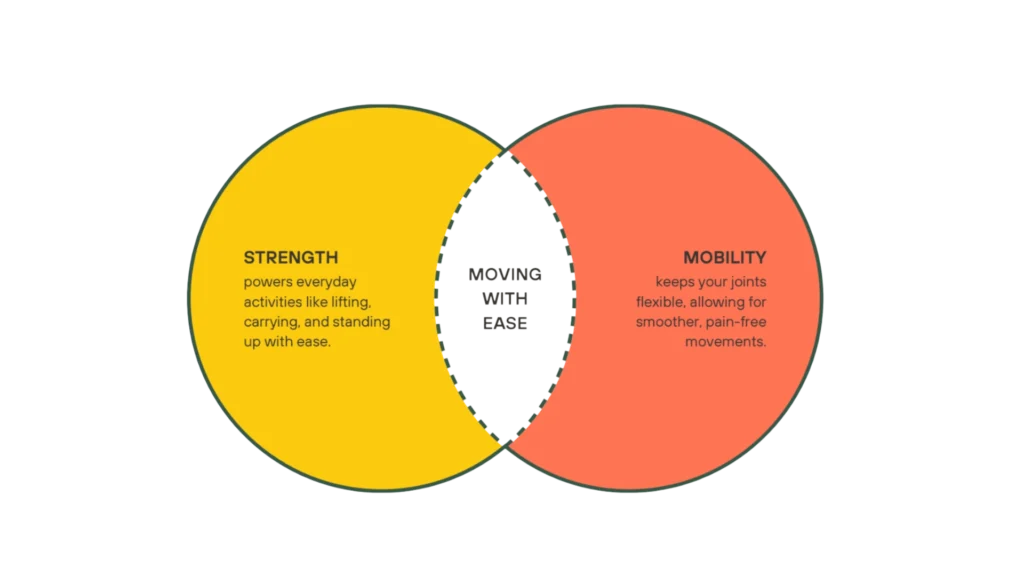Most people think of strength as something you either have or don’t—something for athletes, gym-goers, or younger people.
But for those over 60, strength is one of the most important things we can work on.
It affects everything from how easily you move to how confident and independent you feel in your body.
And the best part? You don’t need a gym, special equipment, or extreme effort to build it.
You just need the right approach.
What Happens to Strength as We Age?
After age 60, most women naturally lose up to 3% of muscle mass and 2% of bone density every year. That’s not just a stat—it’s something you may have felt yourself:
- Struggling to stand up from the sofa without using your hands
- Feeling wobbly on uneven ground
- Noticing it’s harder to lift things overhead
- Avoiding activities that once felt simple
I need you to know that muscle is your mobility insurance.
Lose it, and everything else becomes more fragile.
Keep it and your set for a future life lived on your own terms.
The muscles that support your joints, balance, and posture become weaker over time, unless you actively train them.
Why Strength Matters After 60
Everyday movements require strength.
Whether it’s getting out of bed, walking up stairs, or picking something up off the floor—these actions all depend on how strong and stable your body feels.
When strength declines, things that used to be effortless start to feel uncertain. That can lead to hesitation, fear of falling, or avoiding activity altogether.
But here’s the key: strength is trainable at any age.And the benefits show up quickly.
What Strength Training Really Looks Like
Let’s clear something up: strength training after 60 doesn’t mean lifting heavy weights or doing anything intense.
It’s your stability on stairs.
Your posture when you walk.
Your confidence getting out of the bath.
This is what we call functional strength: movement that mimics real-life patterns, and helps your body do what it was made to do — safely and confidently.
The Power of Strength and Mobility—The Mighty Duo.
Strength and mobility go hand in hand to keep you moving with ease. Here’s why they’re both essential:

Without these two working together, life becomes harder. But with them? You move freely, feel confident, and enjoy all the little things that make life amazing, like playing with your grandchildren, travelling, or simply getting out of a chair without struggle.
The best part? It doesn’t take hours in a gym to build strength and mobility.
Surprising Benefits of Strength Training After 60
Strength training isn’t just about muscles. It’s got benefits that reach across nearly every area of life:
- Improves bone density, reducing the risk of osteoporosis
- Protects joints, making movement feel easier and more stable
- Supports balance, lowering your fall risk
- Speeds up metabolism, helping with energy and weight control
- Reduces pain, especially in knees, shoulders and back
- Improves posture, helping you stand taller and move more freely
- Boosts confidence, because your body starts to feel capable again
- Improves mental clarity and mood, shown in studies to reduce symptoms of anxiety and depression
“My legs are much stronger, whereas before I might have had to use my arms more, now I feel my legs are a lot stronger.” — Catherine, Goodnick member since 2024
Common Myths That Hold People Back
“Isn’t walking enough?”
If you’re already walking most days, you’re doing a lot right. But walking won’t stop strength loss.
It won’t build muscle.
And it won’t stop you from losing balance or flexibility as you age.
That’s why the UK’s top medical guidelines recommend two strength workouts + two balance/flexibility sessions every week. Exactly what we offer here at Goodnick.
Learn more: ‘Walking Is Great — But This Is Better for Strength’ [LINK].
“I’ve never exercised, so it’s too late to start.”
Actually, studies show that even in your 60s, 70s, 80s, and beyond, it’s still possible to build muscle.
You don’t need long hours or intense routines.
You need a system that meets you where you are.
You’re never too old to begin [LINK] — you just need the right support.
“I’ll injure myself if I try.”
When done properly, strength training is one of the safest things you can do to protect your health long-term.
In fact, research shows that it can reduce the risk of falls and fractures by improving balance, muscle coordination, and bone density.
The key is starting with slow, joint-friendly movements and building gradually, something that’s baked into the Goodnick approach from day one.
You’re Not Just Getting Stronger—You’re Building Trust in Your Body
The biggest change we see isn’t just physical. It’s emotional.
Our members tell us that the moment they start feeling stronger, they start showing up differently in their lives. They say yes to more things. They move with less hesitation. They feel more confident and proud of themselves again.
“I feel sharper, more mentally alert. Like myself again.” — Pauline, 70
Simple strength and mobility training isn’t about lifting heavy weights. It’s about living the life you love with ease, confidence, and independence.
